The Military and Hospitaller Order
of Saint Lazarus of Jerusalem
A time for re-unification
In your prayers please ask for Divine guidance at the upcoming Governing Council meeting of The Order of Saint Lazarus. After a period of some considerable differences between the two Obedience's, that is Malta and Paris it had been hoped that the Order would unite under a single Grand Master at a meeting in Canada in 2004.
The election that followed was not recognised by 22 of the 27 jurisdictions as the proposed Grand Master at the time, was not in Communion with the Church of Rome (he was a Roman Catholic and divorced).
In very recent times a new Grand Master Designate has been nominated in the person of Don Carlos Gereda de Borbon, Marquis de Almazan. This nobleman has the Royal Patronage of HM King Juan Carlos of Spain and appears to be acceptable to both Obedience's of the Order.
Voting for the Grand Master Designate is set down to take place in September 2008, and should Don Carlos Gereda de Borbon be lawfully elected then the schism that has been visited upon the Order since the mid-1970's will almost certainly be at an end. As well, with such an esteemed Royal Patron, the Order will surely continue to grow from strength to strength.
"Atavis Et Armis"
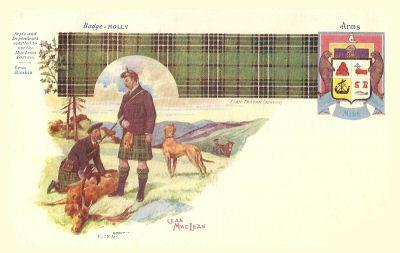

The Noble Society of Celts, is an hereditary society of persons with Celtic roots and
interests, who are of noble title and gentle birth, and who
have come together in a search for, and celebration of, things Celtic.
"Summer Edition 2008"
Financial Report, 2007
Balance forward Combined $5463.92
Income
Dues Received, Operating  $530.00
$530.00
Insignia Sales 

 $545.00
$545.00
Total Income Operating  $1075.00
$1075.00
Dues Received, Tomania  $250.00
$250.00
Total Income, Tomania  $250.00
$250.00
Total Income $1325.00
Expenses
Administration Misc $20.00
Legal & Professional $61.25
Shipping and Insurance $79.07
Awen & Publications $158.14
Total Expenses $318.46
* Budgeted
Insignia Purchases $2000.00
Grants and Awards $2000.00
Operations Reserve $2470.46
Publications & Misc
Ending Balances
Balance, Operating $1691.71
Balance, Tomania $4778.75
Total Cash on Hand, see budgeted $6470.46*
The Financials are approved by the Treasurer,
Chev. Thomas P. Westgaard NSC.

AWARD OF THE COMPANIONATE OF MERIT OF THE ORDER
It has been announced by Chev. Bruce Harrington, Grand Prior of the United States of the Order of St. Lazarus that Dr. John Joseph Egan and Dr. Mary Joan Egan have been awarded the Companionate of Merit of the Order. The honors were announced in the recent St. Lazarus Newsletter. John and Mary Joan are two of our longtime members. Joe's arms are displayed on the Armorial of the Society.
A HISTORY OF THE CLAN DOYLE
“they have taken good care to distinguish themselves”
Many of the Doyle men of Ireland served in the armies of Spain and France to fight against our ancient enemy (England) during the 16th, 17th, and 18th centuries. Nonetheless a great many Irishmen also made very successful military careers in British service, particularly during the 18th and 19th centuries, including some notable Doyle men.
The whimsically named ‘Bramblestown’ estate, near the pretty village of Inistioge in County Kilkenny, nurtured a unique family. Between 1756 and 1856 came a dynasty of military men: a series of six generals, four of them baronets, and several Royal Navy officers. In 1911 a descendant, Colonel Arthur Doyle, did his utmost to sort them out in his book "A Hundred Years of Conflict, Being Some Records of the Services of Six Generals of the Doyle Family, 1756-1856". The number of Doyle generals was too much for the Dictionary of National Biography, which, Colonel Arthur writes, "got them all mixed up", as also did the Gentleman's Magazine. In London, a Court official who was sending out invitations, remarked to the King, "I can never distinguish between them". Said the King, "Perhaps it's just as well that they have taken good care to distinguish themselves".
Colonel Arthur Doyle tells how, "Being Catholic they were bullied by James I and bullied by Cromwell. Possibly they became Protestant by 1690 through marriage to a Scottish widow. Several were in King James's Irish army at the battle of the Boyne. Afterwards they were bullied again by William II who cut off a Doyle head and stuck it on the walls of Kilkenny Castle". They also served with the Irish Brigade in Europe where they were called Doyley and, in French, Doyelle. In the French army at that time, the Irish were at a disadvantage because of the vindictiveness of Sir Robert Walpole, the Whig Prime Minister, who made use of his friendship with a French cardinal to hold up the promotion of Irish officers in the French Army.
Several budding Doyle generals had seen action by the tender age of ten or fourteen, enticed into the army by enthusiastic fathers, brothers or uncles. Between battles they would return to Ireland to cultivate their land, become Members of Parliament or command the local militia. Eventually, they mostly left Ireland for England, though one Doyle baronet, formerly of the Royal Irish Fusiliers, remains in the Republic of Ireland.
General Sir John Doyle, Baronet GCB, KCH (1756-1834), was one of the four sons of Charles Doyle of Bramblestown. A graduate of Trinity College, Dublin, he served with the British army in the North American colonies.
When the War of American Independence ended there in 1784, he returned to Ireland where he was elected Member of Parliament for Mullingar and proved himself as eloquent a speaker as any in that talented, pre-Union, Irish House of Commons.
Sir John raised the famous 87th Regiment (The Royal Irish Fusiliers) at his own expense, in 1793 to serve in the Netherlands where they took very heavy casualties.
At one time he was Private Secretary to the Prince of Wales (who was later to be crowned as George IV of England).
General Doyle’s war service also included campaigns in Flanders, and Egypt.
On 17 May 1801, while commanding the 12th Light Dragoons, he captured the French Dromedary Corps in the Libyan Desert.
He was created a Baronet in 1805. King George III wrote of him to the Earl Marshall as follows, "that his (Doyle’s) zeal and exertions in our service may be known to posterity".
When he retired he was appointed Governor of Guernsey from 1802 to 1813, where his able administration, assisted by a nephew, also John Doyle, is commemorated by an impressive stone memorial column
Major General Welbore-Ellis Doyle (1758-97), Colonel of Britain’s 53rd Regiment, The King’s Shropshire Light Infantry (comprised of mostly Irishmen at that time), served throughout the American War of Independence.
He was in Philadelphia in 1780 On May 25, 1780 when General Clinton appointed Lord Rawdon to command the ‘Volunteers of Ireland’ regiment. Captain Welbore Ellis Doyle of the 53rd Regiment was named his Lieutenant-Colonel.
There's an amusing side note to the appointment of Captain - now Lieutenant-Colonel - Doyle. Lord Rawdon and Doyle were friends, but there's a possibility he was even closer to Doyle's wife, Frances. Contemporary gossip whispered that she was Rawdon's mistress and accompanied him (and her husband) throughout the campaigning in the south. Her first child, born in 1783, was named Frances Hastings Doyle, but if his parentage was at all in question, the fact does not seem to have troubled the "easy going" Lieutenant-Colonel.
Some interesting references to Doyle’s American adventures include the following extracts:
During the war in Flanders Colonel Doyle led the 14th Regiment, The Prince of Wales’ Own West Yorkshire (also containing large numbers of Irishmen) at Famars; he also led the Irish Stormers at Valenciennes; and he commanded the Expedition to the Isle d’Yeo. He also served as Commander-in-Chief and Acting-Governor of the British Colony of Ceylon (now known as Sri Lanka).
A much-travelled soldier, Welbore was Military Envoy to Poland at Warsaw and died in Ceylon at the age of 39.
Major-General Sir Francis Doyle (1783-1839) was created a Baronet in 1828. His war service included Flanders and the Battle of Copenhagen. He also served as the Deputy Lieutenant of the Tower of London, and as Chairman of the Board of Excise.
His son, Sir Francis Hastings Charles Doyle, Baronet (1810-1888), was a well-known Barrister-at-Law, and served as Commissioner of the Customs Service from 1869 to 1883.
He was also a Professor of Poetry at Oxford University, and is best remembered as the author of "The Private of the Buffs" and other poems. He was educated at Eton and at Christ Church College, Oxford, where he took a first-class in classics in 1831. He read for the Bar and was called in 1837. He had been elected to a Fellowship of All Souls' College in 1835, and his interests were chiefly literary.
Among his intimate friends was Mr Gladstone (Prime Minister of Britain), at whose marriage he assisted as "best man"; but in later life their political opinions widely differed.
His son, Captain Francis Doyle, of the 2nd Dragoon Guards, served in the Zulu War of 1879-80. Captain Doyle also served in the Egyptian War of 1882, but died of his wounds on the 2nd of December.
Lt. Colonel Sir John Milley Doyle, Baronet (1781-1856) was granted a ‘Coat of Arms’ in 1815 which include representations of the gold cross with two clasps that was presented to him by the King in testimony of the royal approbation of his distinguished military services in Spain and Portugal. His ‘Coat of Arms’ also includes representations of the Turkish Order of the Crescent and that of a Knight Commander of the Portuguese Order of the Tower and Sword. .
In 1824 Sir John Doyle was detached for special operations against the Spanish, and assisted the South American liberator Bernard O’Higgins.
In May 1854, Sir John Milley Doyle was appointed Sergeant at Arms in the Royal Household of Queen Victoria.
Lieutenant-General Sir Charles Doyle, KCB GCH KC RCS (1787-1848) served with the British army in numerous campaigns; including those in the Netherlands, the West Indies, in the Mediterranean, in Egypt, and in Spain. He was also honoured with the Order of Charles III of Spain and with the French Legion of Honour.
A second battalion of the 87th Regiment (2nd Royal Irish Fusiliers) was raised in Ireland by Sir Charles Doyle in 1804. (Charles was the son of the Regiment's original Commanding Officer, Colonel Sir John Doyle.)
Both Battalions of the Regiment went to Portugal in1809 and took part in the Peninsular War against Napoleon’s armies in Spain and Portugal. The regiment took part in battles at Oporto, and at Talvera and fought a defensive action at Cadiz. The regiment's casualties at Talavera were 40%. The 2nd. Battalion of the 87th. Regiment gained great honour for its valiant action at the Battle of Barrosa. Other Battle Honours of The 87th. from the Peninsular War include Tarifa, Vittoria, Bidarossa, Nivelle, Othez and Toulouse. The 1st. Battalion saw service in Nepal, south of the Himalayas, from 1815 to 1816, then fought against the Pindarees in India, and then took part in the First Burmese War from 1825 to 1826, subsequently returning to England in 1827.
Sir Charles Doyle was the soldier who introduced the "Ca Ira" cry into the British army during a deadly exchange with the French. He was sent to Spain to train the Spanish army and was made a Spanish Lieutenant-General with the Doyle Triadores.
In Portugal he became entangled in politics. However, his honour was vindicated by burial at Windsor.
He was Member of Parliament for Carlow from 1831 to 1852.
Major-General Carlo Doyle was born in Warsaw in 1787 (his Godfather was the Emperor). He joined the British Army’s Coldstream Guards in 1803.
He saw war service in Spain and Portugal during the Peninsula War against Napoleon, and was present at critical battles for Corunna, Talavera, and other actions. In 1809 he was mentioned in dispatches to the Military Secretary of the Commander in Chief in London, by another famous Irishman, the Honourable Sir Arthur Wellesley KB (later to be the Duke of Wellington), who was writing from Castello Branco.
In 1813 he was Military Secretary to Lord Hastings, the Governor-General of India.
He also served in the campaigns against the Pindaries and Mahrattas in India, 1817-8.
Yet another prominent military man of the period was General Sir Charles Doyle KCMG, was Colonel of the 87th Regiment (The Royal Irish Fusiliers) and finally commanded the Southern Military District of England as well holding the post of Lt. Governor of Portsmouth.
He was for sometime also Commander of the forces in Nova Scotia, and afterwards Lt. Governor of the Canadian provinces of New Brunswick and Nova Scotia … as well as Commander of British military forces in ‘British North America’.
He had previously distinguished himself as an officer during war service in the East and West Indies, and as Assistant Adjutant-General of the 3rd Division of the British Army during the Crimea War. He had also served as Assistant Adjutant-General in Ireland, and was Inspector-General of Militia there. He died in 1883.
Another Doyle who appears in naval and military records of the period was Vice Admiral Sir Bentinck Cavendish Doyle of the British Royal Navy (died 1843).
An old edition of "Who’s Who" records the death of The Right Honourable John Sidney Doyle who had been Colonel of the 2nd Battalion of the Oxfordshire Light Infantry, and who had also been a Member of Parliament for Oxfordshire from 1852 to 1885. John married the Baroness of North, daughter of the Earl of Guilford, and took the name North; becoming Lord North.
The records of Britain's York and Lancaster Regiment show that, down at the bottom end of the British Establishment’s rigid ‘class system’, Sergeant J. Doyle was awarded the Distinguished Conduct Medal (Britain's second highest bravery award for enlisted men) for gallantry in action during the "Battle at El Teb in 1884 during the Egypt and Sudan War of 1882 - 1889.
From the London Gazette, Tuesday, May 6, 1884:-
Despatches received by the British Secretary of State for War from the General Officer Commanding in Egypt included the following passage: The 1st York and Lancaster Regiment, a fine battalion of seasoned soldiers only landed on the evening of our march to Fort Baker, on the 28th February. During the action on the 29th February, in which they took a prominent share, being in the fighting line, the 1st York and Lancaster gave me great satisfaction by their steadiness, and by the firmness with which they met and repulsed the charges of the enemy. When advancing on the first enemy battery captured, hand-to-hand fighting ensured. The battalion was engaged in difficult fighting at El-Teb and at Tamai, and heavy casualties were suffered by this battalion. It is on occasions of repulse and retreat, such as that which temporarily befell this battalion at Tamai, that the individual efforts of Officers and men show most clearly and are of greatest value. One Officer and 15 men where killed at the right front corner of the battalion’s “square”. However, they “stood their ground and would not be forced back.” It is on this account that Sergeant Doyle was mentioned by his Commanding Officer as being distinguished for gallantry, and was subsequently awarded the Distinguished Conduct Medal.

The Arctic Tartan
The Arctic Tartan was designed by Rosalind Jones of Mull in Scotland . Inspired by the colours of the geography and natural history of the region, the tartan totally symbolises the ocean, and the land surrounding it, making an attractive combination of colours. The Arctic tartan was inspired by the Antarctic tartan. They are almost identical in colours, yet mirrored in geographical and designed to be ‘twin tartans’, the Arctic , being the reciprocal of the Antarctic in terms of land/sea.
The lines of longitude, 360/0, 90, 180, 270 are depicted as thin bands of white that cross to mark the North Pole. The North Pole lies within the largely ice covered Arctic Ocean that is represented by a large square of midnight blue to represent deep water. Surrounding this is band of pale blue for the ice-cold shallow water at the ocean edges and also the sea viewed beneath the ice floes. A band of white represents these ice floes over the ocean, the ice at the edge of the surrounding continents, and also the polar bears that migrate on the pack ice in summer. A band of black follows, which together with the white, represents the whales and black and white seabirds of the Arctic Ocean .
A thin band of bright green then represents the brief ‘greening’ of the Arctic during the short summer and the fact that, at lower levels, conifers extend just inside the Arctic Circle. A band of orange depicts the orange lichens that encrust rocks whilst coastal rocks and inland mountain
ranges are represented by two bands of grey, which also represents grey animals of the arctic such as seals. White follows representing the snow covered northern continents with their white wildlife such as the polar bears, arctic foxes, wolves, hares and ptarmigan. The outside of the sett is defined by thin threads of pale blue representing the Arctic Circle, which encloses the area of the Arctic . Dark, ‘midnight’ blue also represent the six months of night, whilst the colour cream represents the six months of light.
The Arctic tartan can be obtained through the:ANTARCTIC HERITAGE LIMITED, Kingcoed Farm, Usk, NP15 1DS, UK, or telephone 01291 690305 with your credit card details, or email info@ukaht.org to receive a Paypal invoice.
*******
The Antarctic Tartan
(Reg. Design No. 602938)
The Antarctic Tartan was designed by Rosalind Jones of Mull in Scotland, and as well as being worn by a variety of other Antarctic organisations, it is approved for wear by any member of the New Zealand Antarctic Veterans Association who have done service south, of South 60% for any period.
The colours of the Antarctic Tartan are inspired by Emperor penguins, and by the colours of the geography and natural history of the continent, the tartan totally symbolises the southern continent, the seas, and the ocean surrounding it, making an attractive combination of colours.
The design of each sett is taken from Antarctic geography.
The square of white at the centre represents the ice-covered continent and the light of the Antarctic summer, a thin cross of blue is added to represent the four compass points and where they bisect at the South Pole.
The grey rock of nunataks and partially buried mountain ranges are symbolised by a band of grey, within the white of the continent, whilst rocks emerging at the edges of Antarctica are represented by a broader band of grey. Within this, threads of pale blue represent the 0/360, 90, 180 and 270 degree lines of longitude and the point where they cross - the South Pole.
Two bands of grey depict mountain ranges and exposed coastal rocks. Animals and simple plant life are found around Antarctica's coast so the colours that follow, orange, yellow, black and white represent not only penguins but also the wealth of other animal life on land and in the seas.
Orange also represents the lichens encrusting the rocks. On these rocks orange lichens grow and so a band of orange lies adjacent. The colour orange is also one of the colours of Emperor Penguin’s plumage, and this together with the following bands of yellow, black, and white (representing their plumage and black and white of marine mammals), symbolise the land and marine animal life of Antarctica.
Pale blue and white depict the ice shelves, with a thick band of midnight blue for ocean deeps and dark winters.
Each tartan sett is separated by a thin white band, representing the Antarctic Circle. Where bands of white cross over, the stars of the Southern Cross are depicted".
The thin band of white also represents the thin ice shelves covering the shallow ntinental margins, the pale blue that follows the blue shelf seas, whilst the dark blue adjacent represents the deep Antarctic Ocean. The thin band of white on the outside symbolises the Antarctic front, the limits of the Antarctic Ocean. Finally the dark colour of the ocean surrounding the light colour of the continent is symbolic of the sombre darkness of the Antarctic winter against the enlivening light of the summer.
The Antarctic tartan can be obtained through the:ANTARCTIC HERITAGE LIMITED, Kingcoed Farm, Usk, NP15 1DS, UK, or telephone 01291 690305 with your credit card details, or email info@ukaht.org to receive a Paypal invoice.

A NEW KING OF ENGLAND, SCOTLAND AND NORTHERN IRELAND?
The British Prime Minister, Gordon Brown is considering repealing the 1701 Act of Settlement as a way of healing a historic injustice by ending the prohibition against Catholics taking the throne. The repeal of the Act would have the unforeseen consequence of making German aristocrat HRH Franz Herzog von Bayern, the current Duke of Bavaria the rightful heir to the Crown of England and Scotland under the Stuart line.
74-year-old HRH Franz Herzog von Bayern is a great-grandson of the last King of Bavaria, Ludwig III, who was deposed in 1918. He is also the current senior co-heir-general of King Charles I of England and Scotland, and thus is considered by Jacobites to be the heir of the House of Stuart and the rightful ruler of England, Scotland and Northern Ireland. The bachelor, who lives alone in the vast Nymphenberg Palace in Munich, is the blood descendent of HM King Charles I. "If it [the Act] were to go ahead, then the whole Catholic line is reinstated," said Professor Daniel Szechi, a lecturer in early modern history at the University of Manchester. "Franz becomes the rightful claimant to the throne. We would just exchange one German family for another one."
The Act was introduced as part of the power struggle between Parliament, the Christian churches and the monarchy, then dominated by the House of Stuart. It prohibits any Roman Catholic from having access to the throne, even through marriage. Once a person marries a "Papist" they shall be "for ever incapable to inherit, possess or enjoy the Crown", it asserts. The legislation effectively severed the Stuart line of succession, a family who favoured Catholicism, and switched it to their distant relatives the Hanoverians, from which our current Queen descends. James II, the son of King Charles, fled into exile.
The Stuarts stopped making claims to the Crown after the death of Henry Benedict Stuart (known to the Jacobites as Henry IX) in 1807, but there remains bitter feeling among many Catholics at their treatment. The Royal Stuart Society still holds annual vigils at the bronze statue of Charles I in Trafalgar Square. (Source: Richard Alleyne and Harry de Quetteville. Telegraph)
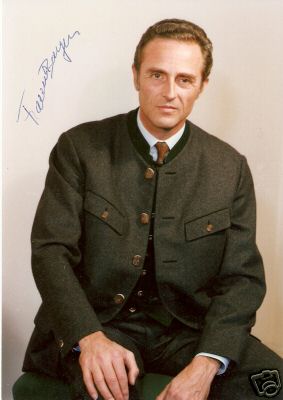
The Secretary to HRH The Prince of Wales has acknowleged the Prince's receipt of our last AWEN in a note to the chancellor from Clarence House.
An early 20th century colour post card featuring Scottish themes. This style of embossed and chromolithographed card was very popular for the world travelers of the Edwardian era. This one features the MacLean tartan.
A Celtic Kilt pin
Noble Society of Celts members Mr & Mrs Jack Bess at a hereditary society event in 2007.
Note: Jack is wearing the neckbadge of the NSC.
Jim Sloan, HSC, Piper to the Chancellor of the NSC.
THE ARMS OF O'CONOR DON
by Michael Subritzky-Kusza Ct, NSC.
Arms: Within a manteau (or in this particular case a pavilion) which is topped by a ducal crown,
and displaying the device of Connaught on the sinister flank of the folds (removed in this particular
colour rendition). The tinctures of the arms are described as "argent an oak tree eradicated vert,"
(sometimes proper), the lion supporters being "gules, armed and langued azure," and the antique
crown and harps "Or."
Motto: "Lam Croga Eirinn" which translates as "The Spirited (Brave) Hand of Ireland."
Prior to the Independence of Ireland on the 06th December 1921, the Office of Arms of the British Government office, did not recognise any of the Irish chieftainries except in one case. In 1900, O'Connor Don was granted supporters (Lions), and at the coronation of Edward VII he was officially appointed to carry the standard of Ireland in the ceremonies on that occasion.
The succession of descent within this most noble Celtic family continues unbroken since 76 AD to the present day, making the Royal House of Connaught one of oldest royal families in Europe.
Over the last several hundred years, members of the O'Conor family have continued to contribute to the social, political, cultural and religious life of Ireland. The O'Conor family remained staunchly Roman Catholic during the dark days of the Penal Laws in the eighteenth century, and this is a source of great pride within the family.
The present holder of this ancient Celtic title is Desmond O'Conor Don.
Ref: A.E. Tonson, The New Zealand Armiger, June 1992.

Noble Society of Celts grant to Father O'Reilly House
Sisters of Saint Joseph
Remarks of Roger Carlton Sherman, the Chancellor of the Noble Society of Celts:
The Noble Society of Celts, a private organization honoring things Celtic, sees in the Father O'Reilly House a manifestation of the continuing influence of the Celtic Heritage.
Father O'Reilly was born in Ireland, the virtual seat still today of Celtic heritage, was educated in Spain, and was sent to the New World to further his religious teaching and convictions. He is indeed a symbol of the movement and influence of the Celtic peoples as they swept first across southern Europe from the east then eventually encompassed all of Europe and the British Isles. On behalf of our Chieftain, the Much Honoured, the Baron of Elphinstone, and the thirty-some members of the Noble Society from Europe to Australia, it is my pleasure to present to the Sisters of Saint Joseph this check in the amount of five hundred dollars for the continued preservation of this important house.
Additional Note:
Joining Chevalier Sherman from the Order of Saint Lazarus are Chevalier Thomas Jefferson Hughes II, KLJ and Dame Theresa Garnhart DLJ.
Tribute
Chevalier Dennis Endean Ivall KLJ, NSC (hon), pp.
1921 - 2006
Chevalier Dennis Endean Ivall was born in Essex in 1921. He went from grammar school to work at ICI for a short while before going off to war where he saw service in India, Burma, Ceylon and the Cocos Islands. After demobilisation he attended South-west Essex Art School and later London University gaining a National Design Diploma and a Art Teaching Diploma. He went to Devon were he spent the next twenty years teaching art at Barnstaple Boys School until he retired and became a professional Artist. He moved to his mother's county of Cornwall and established his studio and home near Truro.
His life long interest in heraldry and symbolism, coupled with his Cornish background lead to his instantly recognisable Celtic Art style so evident in his bookplate design. He has written and illustrated two books, Cornish Heraldry and Symbolism and Cornish Military Insignia and still designs heraldic illustrations and bookplates for clients throughout the world. It seem quite strange that Dennis was not commissioned to design his first bookplate until 1981, his sixtieth year. Since then his designs have become most sought after by bookplate collectors and commissioning book owners alike.
His life long interest in heraldry and symbolism, coupled with his Cornish background lead to his instantly recognisable Celtic Art style so evident in his bookplate design.
Chevalier Dennis Endean Ivall is considered by many to be the foremost heraldic artist of the 20th century he passed away in Truro, Cornwall, on the 06th February 2006.
Above are 2 examples of his work, both are bookplates of his own arms, one in colour and the other in black and white.
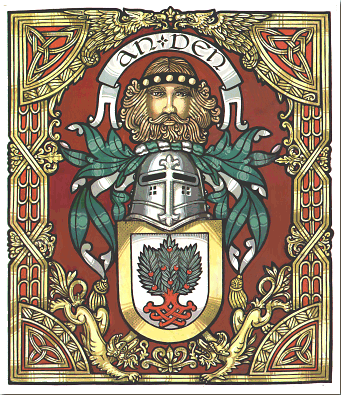
Coat of Arms of the O'Dowd Clan
Description:
ARMS - or a saltier sable, in chief two swords in saltier, in base and oak leaf, the stalk upwards, vert.
CREST - over a coronet, a dexter hand in armour, holding a dart, proper.
MOTTO - "Virtus Ipsa Suis Firmissima Nititur Armis" (Bravery is Best Sustained by Arms). Authority Chief Herald of Ireland 1574.
CELTS DOWN UNDER
A brief history of the O'Dowd Clan and the Kings of North Connaught
by Michael Subritzky-Kusza Ct, NSC.
"Once upon a time in a beautiful green land, far, far away there lived a beautiful Princess in a great castle, and her father was the ruler of a great kingdom..." or so many a children's bedtime story used to begin, back in the days before television and computers.
I was born in New Zealand with the full knowledge of my paternal (Polish) nobility, however my grandmother often told me that her own O'Dowd ancestors were also noble, (and royal) and had castle's of their own.
It wasn't until many years later when one of my sons married an Irish girl and I actually went to Ireland that I actually came to realise just how historic and prestigious my grandmothers Irish lineage actually was. Her forebears had actually owned an Irish Kingdom and had ringed it with castles and held it against all invaders until the time of Cromwell. Finally, refusing to give up their Roman Catholic faith they had been starved off their lands and many forced to join the British Army if only to support themselves and their loved ones. I speak English, Maori (Native NZ), and some Polish so I find the actual spelling and pronunciation of Gaelic totally impossible so I will include in this article an English transliteration of the pronunciation of various Irish words.
The Royal O'Dowd's
Ancient History: As the various megaliths that dot County Mayo and Connacht such as Ceide Fields show there has been human habitation in these areas of Ireland since the time of the stone age. Those ancient people's believed in an afterlife and worshiped all that they saw around them, including sun, moon, stars, water and trees. Their entire world was one of magic. The "O'Dubhda" family (pronounced O'Dooda), descended from a tribal people in the west of Ireland once known as the Ui Fiachrach ("Ee Fee-a-crock").
Ancient Kings: King (Ri) Echu Mugmedon who died in 366AD was King of Connacht until 358 AD, when he also became Ard Ri (High King) of Ireland. During this time, the Irish carried out raids on the coast of Roman Britain and took many captives whom they sold as slaves - King Echu was known as the "Lord of Slaves." His wife was Mongfinn, daughter of Fidegh, King of Munster, and their children were to found the principal families of Connacht - O'Connor, O'Dowd, O'Heyne and O'Shaughnessy.
The next king of note was "Niall of the Nine Hostages." In 402, when King Niall was killed, Daithi was elected High King at Tara. Daithi was the son of King Fiachra ("Fee-a-cra").
King Daithi set about establishing order at home, before setting out to Gaul to avenge the death of Niall, (although Niall had actually been killed by an Irishman). Landing in Scotland, he defeated Feredach Finn and his army of Picts, Britons and Scandanavians, and received hostages from all the kingdoms of Alba. Daithi was said to have offended the hermit, Saint Formenius and was struck by lightning and killed. His son, Aillil Molt, took command of the army and set out for Ireland to bury Daithi in the royal burial grounds. On the way back they were attacked several times and the Annals claim that 10 battles were fought on land and 9 at sea. The names of some of these battles are - Corpar, Conge, Cime, Colom, Faile, Miscal, Lundunn, Corte, Moile, Grenius and Fermir -although the locations are now unknown.
In all of these battles, the Irish were victorious, as their enemies were led to believe that King Daithi was still alive, and fled in terror. This was achieved by King Aillil having a burning sponge placed in the mouth of the dead king, and the vapours from this made it seem that he was still breathing.
King Aillil Molt, son of Daithi, succeeded to the throne at Tara about 460, and reigned for 20 years
On their return, the Irish buried their High King Daithi in the Royal Rath at Cruachan, and erected a red pillar to mark the place where the last pagan High King was laid. Years later, this pillar fell over, apparently fulfilling the curse of Saint Formenius that Daithi should have no lasting memorial. This situation has since been rectified and the stone is again upright. The new High King, Laoghaire, son of Niall, was converted to Christianity by St Patrick, whom his father had first brought to Ireland as a slave. For another 400 years, the Ui Fiachrach provided Connacht with her Kings, but there was opposition from the Ui Neill and Ui Briuin Clans for much of the period.
In the reign of King Cathmug +787, the Ui Briuin ancestors of the O'Connors successfully opposed the King and took over the Kingship of Connacht. As a result if these incursions, the Ui Fiachrach was split into two groups: Ui Fiachrach Aidhne in County Galway, and Ui Fiachrach Muaidhe in Sligo and Mayo and it was the latter group, the Ui Fiachrach of the Moy, that provided the Kings of North Connacht.
In about 800, the Vikings became a serious threat to the coast of western Ireland and Ui Fiachrach, burning Inishmurray in 807. Cathmug's nephew Dubhda became King of North Connacht in the 9th century, and in 891 the Clan slaughtered a Viking party, killing Elair, son of Barid of Limerick
In the late 10th century, the King of North Connacht was Aedh Ua Dubhda, (Aedh, grandson of Dubhda), and his descendants continued to use this as their surname to this day. There are some 40 spelling variations of the name but the root name is Dubhda "The Dark One"), perhaps the best known spelling is O'Dowd.
The O'Dowds remained kings of their kingdom in North Connacht until the late 13th century, however as history records, great changes were taking place in all aspects of Irish society. The refusal of the Clan to renounce Roman Catholism resulted in the loss of ownership and control over much of their formed lands, eventually being confined to the barony of Tireragh ("Tea-rare-ra"), meaning "The country of Fiachra" (O'Dowds Country), in Sligo.
Taoiseach: As a direct result in the reduction of their lands and power the Clan gradually dropped the use of the title of king, and this title was replaced over time with the title of Taoiseach ("Tea-shock"), which translates as Chieftain. That man who became Taoiseach was generally referred to by his surname only...O'Dubhda, or The O'Dubhda. In this way he came to be referred to in history as "Chief of the Name."
The last Taoiseach: Tanaiste (Heir) Tadhg Bui O'Dubhda of Dunneil Castle, Dromore West, succeeded his brother as Taoiseach (Chief) in 1595. In about 1600, Tadhg took 100 Clansmen to Ballymote Castle to join his brother-in-law, Red Hugh O'Donnell, and together they marched to Kinsale. After the battle there in 1601, Tadhg never returned to his homeland, but it is believed to have settled in County Kerry, where he founded a branch of the O'Dubhda Clan. Tadhg Bui O'Dubhda was the last Taoiseach to be formally installed according to the ancient Brehon Laws.
The Great Book of Lecan: The O'Dowd Clan is unique among the Irish Clans in having a written, detailed account of the ceremonies associated with, and the inauguration ceremony of their Taoiseach (Chieftain). This was written in an ancient manuscript known as the Great Book of Lecan, written by the Clan historian Duald MacFirbis, near Enniscrone in Tireragh between 1397 and 1418, and now carefully preserved in Dublin. Duald was a noted scholar with a knowledge of Latin, Greek and English, as well as his native Irish, and was the foremost authority of the age on Brehon Law.
The inaugural ceremony of each succeeding O'Dubhda (O'Dowd), was presided over by a MacFirbis, the hereditary chroniclers of the O'Dowd Clan.
Election of the Chief: According to Brehon Law, a Chieftain was succeeded by the oldest and most worthy descendant of the direct line of the original chieftain - in the case of the O'Dubhda, this was Fiachra Ealgach.
There were several conditions that must be met by the candidate:-
1. He had to be a descendant of the blood of the original chief:
2. He must be free of defects or deformities:
3. He must be of age to lead the clan in battle:
4. He had to have the support of the majority of the clan's sub-chieftains and freeholders. Thus it was unusual for a son to succeed his father, and it also happened that some chiefs did not have the support of all of their clansmen.
Inauguration of the Taoiseach: Every clan had an appointed place where their Chieftain was installed, in the case of the O'Dubhda, there were two such sites - Carn Amhalgaidh in Tirawley (Mayo) and Carn Inghine Briain in Tireragh (Sligo). At the designated place there was a stone with the imprint of two feet, reputedly those of the original chief (ie. Fiachra Ealgach for the O'Dubhda). The presence of two sites may have been the result of the civil war between the Sliocht Ruairi and Sliocht Bui in the 15th century, or a geasa (tapu/magic) about crossing the River Moy in ancient times, or perhaps something that was forced on the Clan as the territory it held was reduced to Tireragh and the original site at Carn Amhalgaidh was lost.
The Ceremony of Inauguration:
1. The hereditary historian of the O'Dowd Clan, MacFirbis, would read to the Taoiseach-elect the laws relating to his conduct and he, after listening to them, would swear to observe the laws and customs of the territory.
2. After taking the oath, the taoiseach-elect would put aside his weapons and the brehon would pass a white rod over the chieftain's head. The rod would then be handed to the chief to symbolise his authority and that he required no weapons to ensure the loyalty of his people. In the case of O'Dubhda, his weapons and battledress were given to O'Caoimhin, the senior sub-chieftain and hereditary marshal of the army of Tireragh, and the battledress and weapons of O'Caoimhin were given to MacFirbis, the historian, to stress that they too were of the race of Fiachra.
3. The new chief was proclaimed by having his name shouted by those present, starting with O'Caoimhin and MacFirbis, and with others joining in according to their rank, until the whole counytryside reverberated to the cry of "O'Dubhda! O'Dubhda!"
4. Finally, the chief turned around sunwise, three times to view his Clan, his people and his territory. After the arrival of Christianity, this was said to be done in honour of the Holy Trinity.
Choosing the Tanaiste: It as not unusual to also choose a Tanaiste or heir at the same time as the Chieftain was elected. This was done so as to prevent the Clan being left leaderless should anything happen to the Chief. The Tanaiste did not have to undergo the ceremonies described above, but he was required to take the oath, with one foot on the inauguration stone.
O'Dowd Castles: The Ui Fiachrach (O'Dowd's) provided successive kings of what is now County Mayo and north Connacht over many centuries. They forged a kingdom in North Connacht which they ringed with 24 castles, often referred to as "10-Pound Castles," 20 of which have been identified and named. Most are today in ruins. Their territory at its widest embraced the baronies of Erris and Tirawley in Mayo and Tireragh in Sligo. The style and design of these small Irish castles is said to have originated from a subsidy of 10-Pounds which was granted by King Henry IV in 1429. However, many of the O'Dowd castles have a far more ancient history of being built directly over the site of stone age and bronze age fortifications.
The location of these castles are as follows: No:1 Lough Conn, Enniscone; No:2 Mount Balcon, River Moy; No:3 Beaufield; No:4 Belleek Castle, Ballina; No:5 Castleconor, River Moy; No:6 Castleton Manor; No:7 Inishcron; No:8 Carahduff; No:9 Rathlee; No:10 Rosslee, Easky; No:11 Dromore; No:12 Doonecoy; No:13 Cartron; No:14 Dromard; No:15 Lomford; No:16 Flooneen; No:17 Ballymote; No:18 Markcree; No:19 Lough Gill; No:20 Drumcliff Bay.
The Modern O'Dowd Clan: Due largely to the efforts of a few dedicated people, led by Clan historian Conor MacHale and his Mother Gertie MacHale, both of whom are fluent gaelic speakers, historians, and as well can read and write the language, the Clan was reformed in 1990. A very successful Clan rally (the first in 400 years), was held. The gathering included a feast, various tours of the ancient kingdom, the planting of a Rowan tree (the Clans magical tree of ancient times), and the unveiling of a commemorative plaque by Francis O'Dowda, a direct lineal descendent of one of the last O'Dubhda Chieftains. The Great Feast is usually held in beautiful Belleek Castle, which is actually built over the site of a much earlier O'Dowd castle.
The Modern Clan and Chieftain: Thomas "Tom" Dowds of Glasgow was elected as the Clan Taoiseach (Chieftain) at the Clan Rally in 1997, and served the Clan in that appointment until 2003, when he handed the white staff of office, the O'Dubhda standard, and the Chief's personal pennant to his successor, Richard F. Dowd, of New York.
At the same ceremony Edward O'Dowd of Chicago was elected Tanaiste (Heir).
The Clan has also held ongoing and very successful rallies as follows: - 1990, 1992, 1994, 1997, 2000, 2003, and 2006.
Sources and References:
"The O'Dubhda Family History" Conor MacHale, Clan O'Dowd Historian, Inniscrone, 1990.
"Clann Ui Dhubhda Nauchtlitir" Clan Newsletter ISSN: 0791-5799, 1990 - .
HY-FIACHRACH - O'Dowda's Country. John O'Donovan, ISBN: 0-940134-38-1republished 1993.
The Official Clan O'Dubhda Website.
Interview Mrs Gertie Conor MacHale September, 1999.
Tour of the O'Dowd Kingdom conducted by Conor MacHale September, 1999.
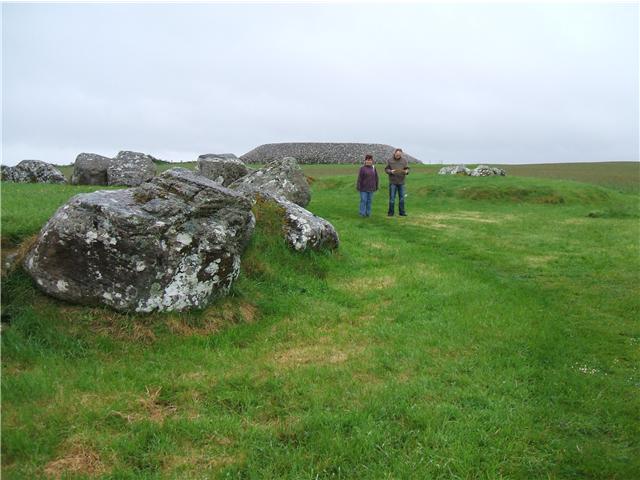
Stone age megaliths at Carrowmore. Co Sligo, Ireland, 2007.
Subritzky Collection.
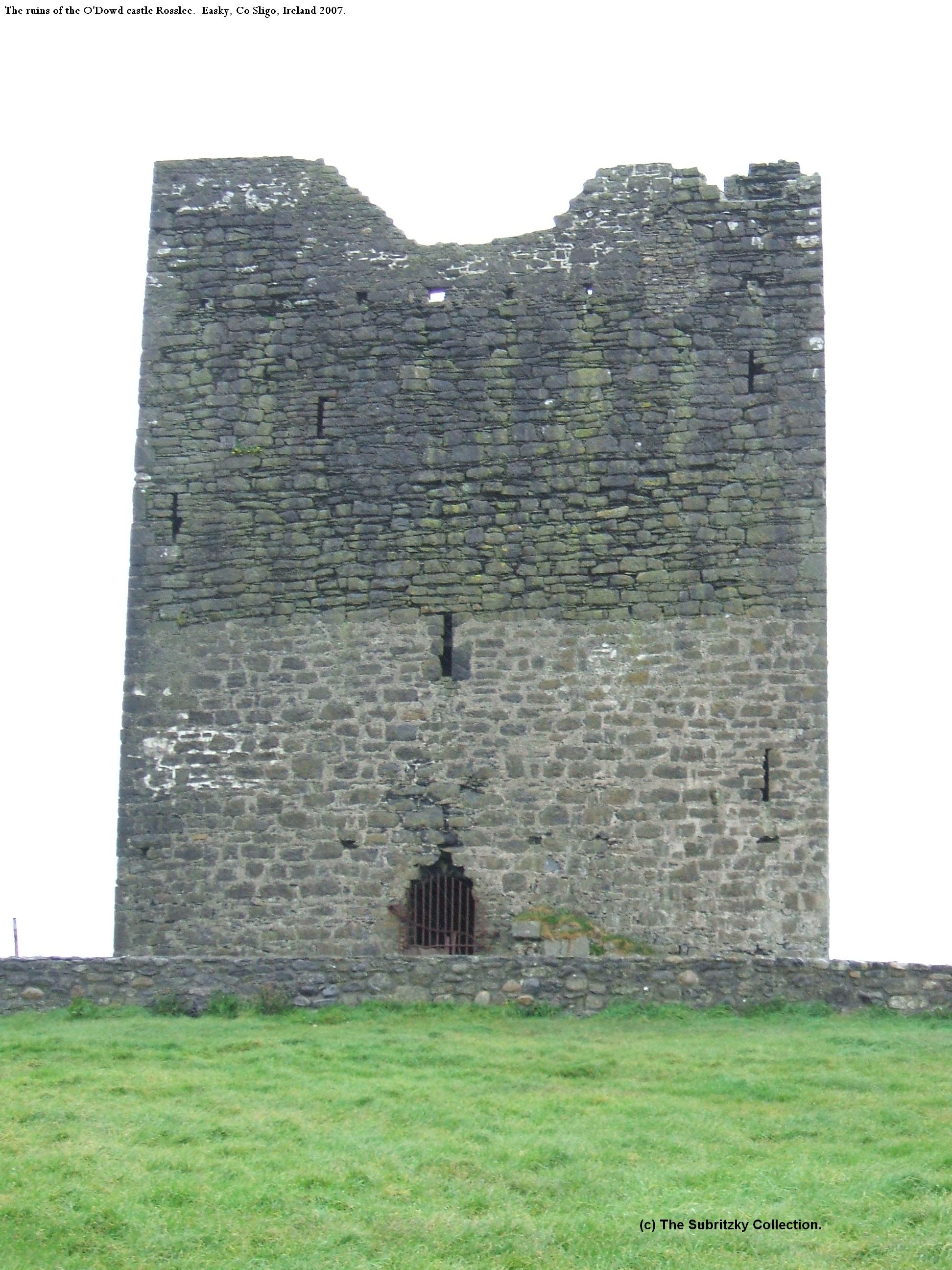
The ruins of the O'Dowd castle Rosslee. Easky, Co Sligo, Ireland 2007.
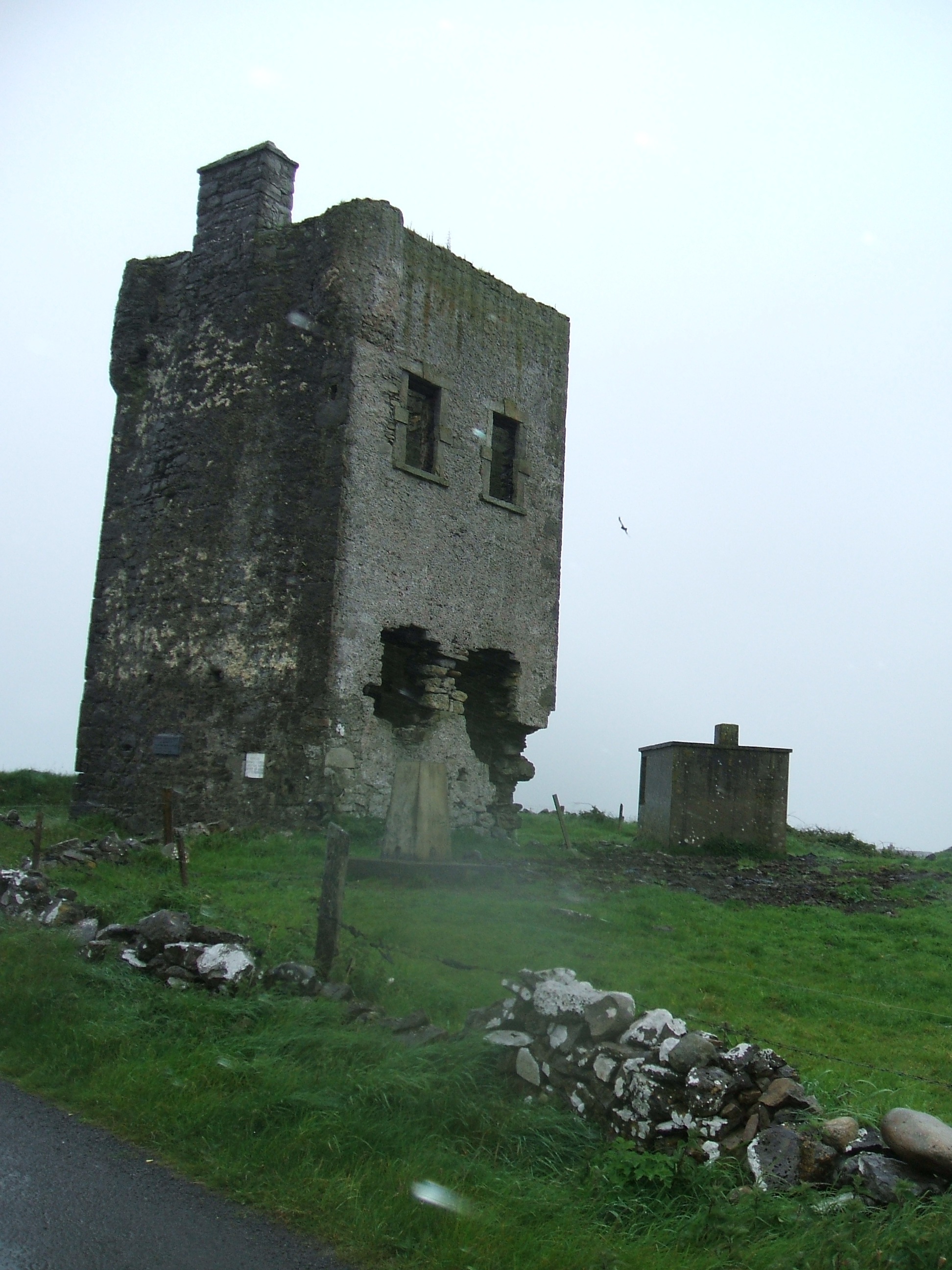
The ruins of the O'Dowd castle Rathlee.
Rathlee village, Co Sligo, Ireland. 2007.
(c) Subritzky Collection.
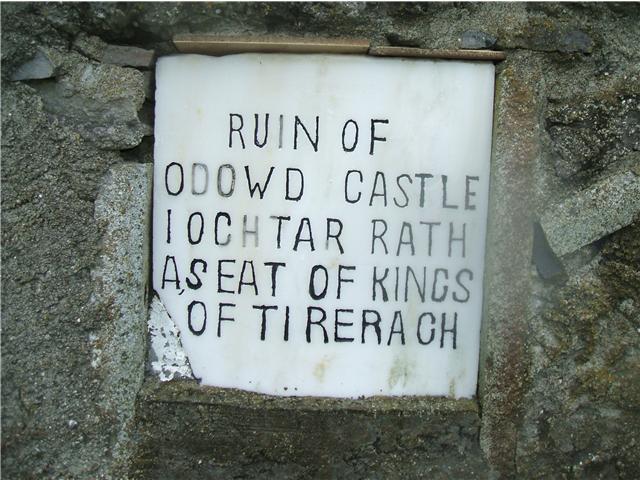
Memorial to the O'Dowd Kings,
Rathlee castle, Co Sligo, Ireland. 2007. Subritzky Collection
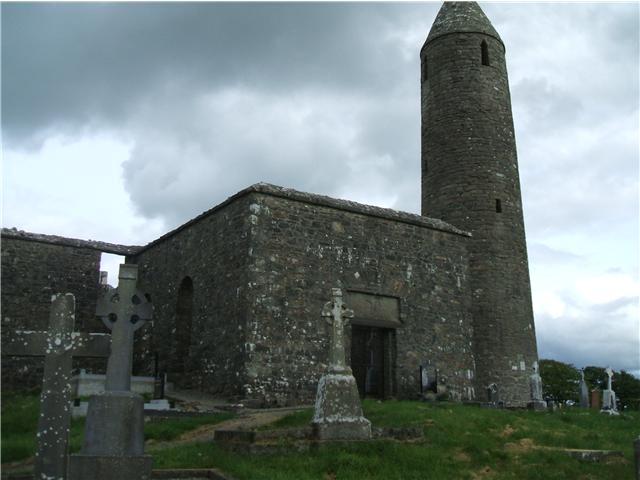
Ruin of an Abbey with a "Viking Tower,"
(the Monks refuge during Viking raids),
Castlebar, Co Mayo, Ireland. 2008.
(c) Subritzky Collection.
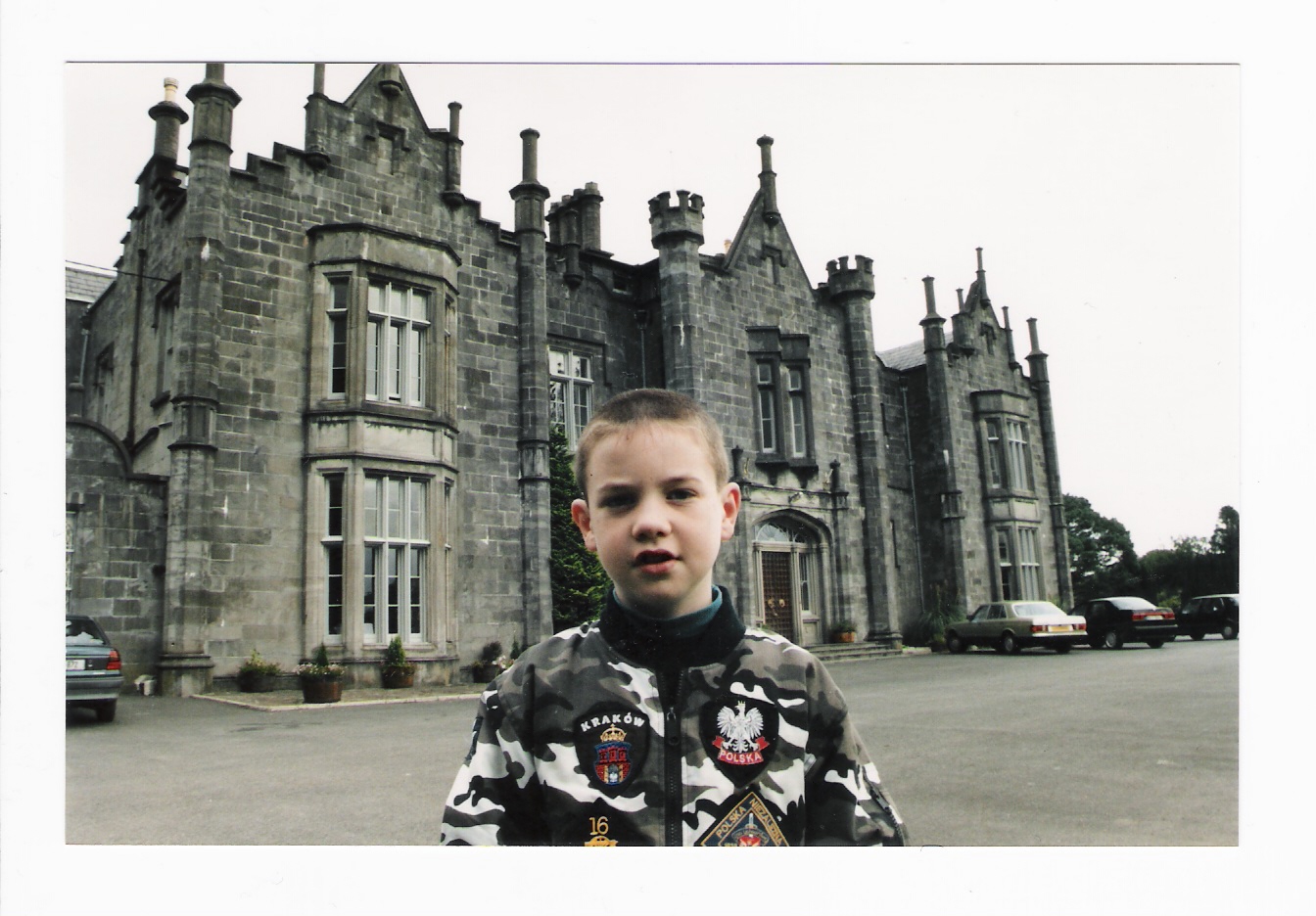
Count Isaac Subritzky-Kusza
Belleek Castle, Ballina,
Co Mayo, Ireland 1998.
(c) Subritzky Collection.
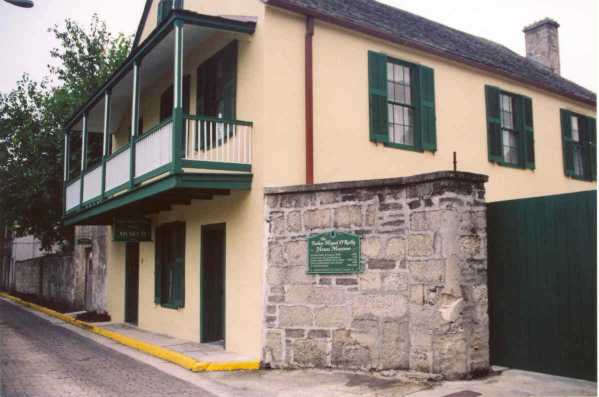
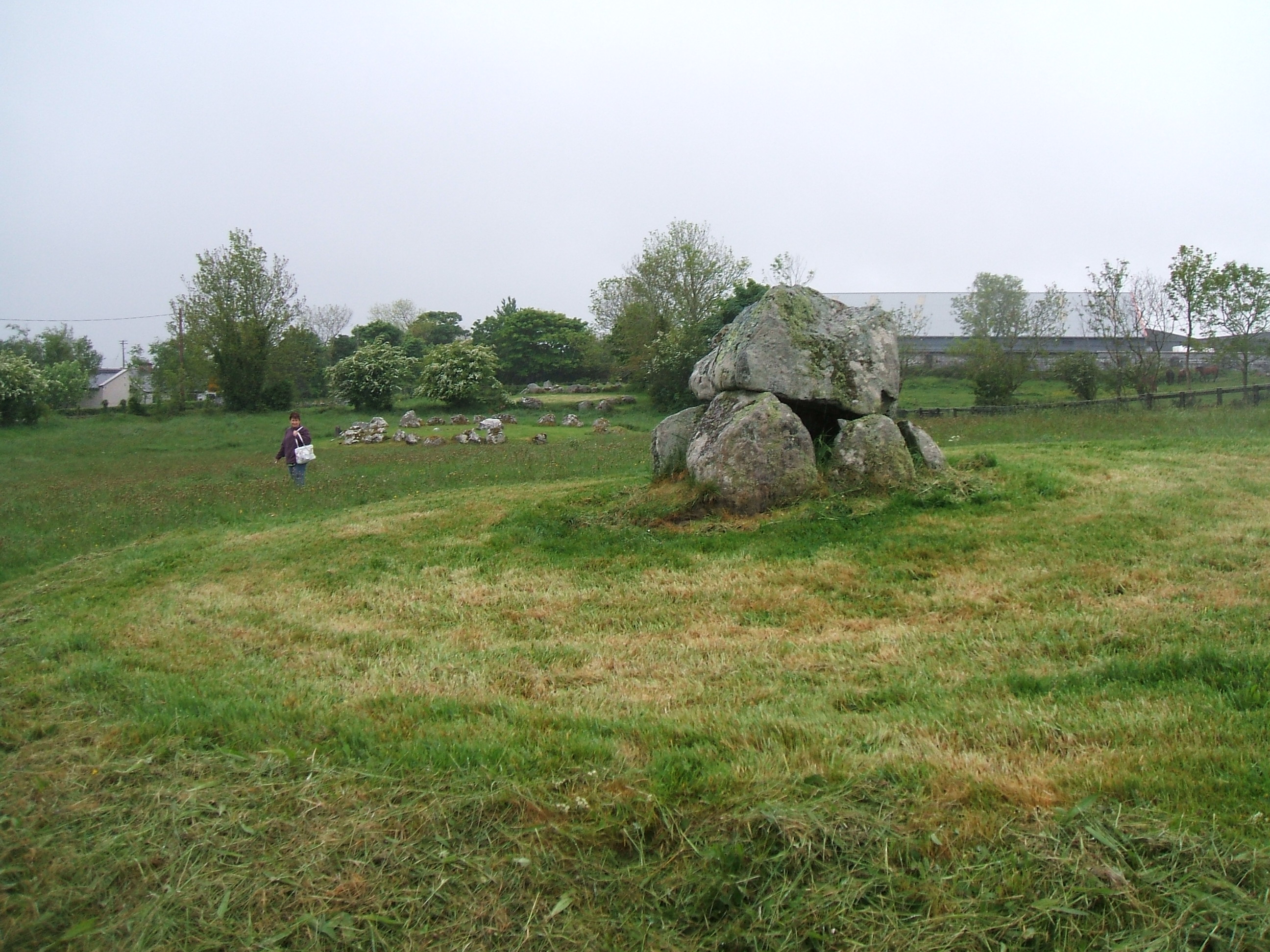
Carrowmore megalithic cemetery. A dolmen tomb and 2 stone circles. Radiocarbon dating suggests 4,000 BC. Co Sligo, Ireland, 2007.
Subritzky Collection.